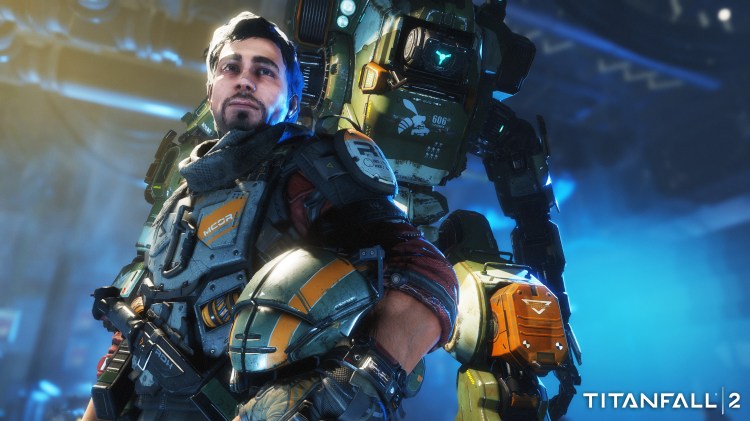When the original Titanfall debuted in 2014 on the Xbox One and Xbox 360, everything was a rush job. Respawn Entertainment had to hire its team, fight off an Activision lawsuit (for allegedly stealing all the talent at Infinity Ward), and create a first-person shooter game in a sci-fi setting.
But it all turned out great, as the game’s fast and fluid multiplayer was extremely addictive, with new features such as mech-like Titans that fall from the sky, as well as wall-running and vertical combat. And Titanfall generated $500 million in retail sales, a huge validation from fans for Chatsworth, Calif.-based Respawn and its publisher Electronic Arts.
Now, Titanfall 2 is poised to debut on October 28 on the Xbox One, Windows PC, and PlayStation 4. It will have both a single-player campaign and multiplayer, with a total of six Titans and new features in combat, such as stealing batteries from the Titans and turning them over to your own team. The single-player campaign follows the growth of a Grunt soldier named Jack Cooper and his ambition to become a Titan pilot during the war between the Frontier Militia and the Interstellar Manufacturing Corp. (IMC).
The veteran developers behind this title include Dusty Welch, chief operating officer at Respawn, and Drew McCoy, producer of Titanfall 2. We caught up with them at EA’s headquarters in Redwood City, Calif., this week. I played some of the single-player campaign, which started out gentle and ended in a frenzy. Then I interviewed them. Here’s an edited transcript of our interview.

Above: Titanfall 2 developers Dusty Welch (right) and Drew McCoy.
GamesBeat: Tell us what you set out to do with Titanfall 2.
Dusty Welch: Some of the guys started out making Medal of Honor way back in the day. They moved on to make Call of Duty to take down Medal of Honor, which is kind of ironic. Then they move on and make Titanfall to, I guess, take down games like Call of Duty. The full circle would be to someday make Medal of Honor again, but here we are today.
The first Titanfall game was March of 2014. Basically a single platform at launch, Microsoft-exclusive, also on PC. Went on to do about half a billion dollars in sales. Highest-rated first-person shooter during that launch window and for a good year afterward. The audience loved it, and it was EA’s best-selling new IP in their history. That was encouraging.
For us, the first Titanfall was kind of a proof of concept, trying to innovate in the genre and come up with something new. “Something new” ended up predominantly in multiplayer, which was that fluidity of movement, the motion model that was built. You had the small thing — a pilot — and the large thing — a Titan — and how they interacted together, with the ability to get out at any time and interact with the environment. To be so mobile was unique. Most shooters are corridors and hallways, playing whack-a-mole.

Above: Titanfall 2’s Ion Titan.
GamesBeat: And now we have sci-fi and wall-running in Call of Duty.
Welch: There are attempts at it. [laughs] It’s great flattery, right? You innovate and people follow you along the way. It was a good proof of concept. Titanfall 2 is the next big leap for Respawn, making arguably the next big first-person shooter franchise. It took Call of Duty a lot of iterations to get where it is today. It’ll take Titanfall a couple to get there as well. But this is a great first step.
Multiplayer, first of all, is very balanced, honed, and refined in Titanfall 2. It’s repeatable and learnable. Drew likes to say that we can’t just say, “We did this and now multiplayer feels right,” the way Modern Warfare felt just right. It’s never one thing you do to get to that level. It’s the sum of so many parts.
From a Titan standpoint, there are now six new Titans versus the three in the original. We have more of a Street Fighter approach, if you will. They’re more class-based, for a reason. They appeal to a broader range of people with different types of play styles. That’s important for the variety and depth of gameplay.
A huge amount of customization has gone into the pilot, the Titan, and the weapons, which wasn’t there before. The progression and unlock curve is very deep compared to the first game. That was the big criticism of the first game. The first 10 minutes of Titanfall, people said it was the greatest game ever made, but there wasn’t a lot of depth after that. The concept was there, but now we have that great depth behind the multiplayer.
We have a real single-player campaign. It’s different. It’s not the traditional hallway shooter that we’ve been guilty of making throughout our careers.
GamesBeat: I was never the most skilled player. I remember, to get through the ladder, I defaulted to the one with the ball grenades, the arc grenades. You’d just lob them continuously, everywhere.
Drew McCoy: That was a big focus on the first game, trying to make a shooter for a wider variety of players. You don’t have to be the most amazing twitch player to have fun and find things to enjoy in it. That’s where stuff like the smart pistol came from. Grunts were there to serve lots of purposes, but one of them was to give more players an easier target.

